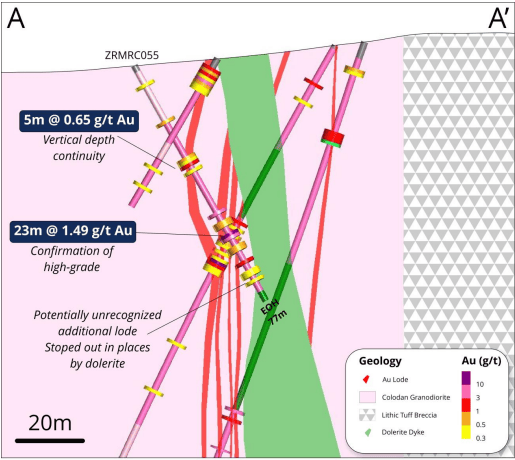Zenith hits thick gold ahead of key diamond drilling at Red Mountain

Zenith thinks Red Mountain bears similarities to major Queensland gold mines. Pic: Getty Images
- Zenith Minerals hits 23m at 1.49g/t from just 48m at Red Mountain
- The company believes the project has analogies to the 1.5Moz Mt Wright mine at Ravenswood
- Zenith is chasing $250,000 in government funding to support deep diamond drilling to understand controls and depth of mineralisation
Special Report: Zenith Minerals has caught the eye with thick gold intercepts from its Red Mountain discovery inland of Bundaberg in north Queensland.
Sitting in elephant country in North Queensland, the results suggest Zenith could be in the right postcode and geological settings to outline a potential major copper-gold porphyry discovery.
The hits and nature of the mineralisation have Zenith Minerals (ASX:ZNC) talking about the project as a potential analogue of the major Mt Wright and Mt Rawdon mines in the Sunshine State, collectively responsible for ~3.3Moz of gold production for some of Australia’s largest gold miners.
The headline strike of 23m at 1.49g/t from just 48m deep in hole ZRMC055 – including an intercept of 2m at 11.3g/t from 55m – comes ahead of critical deep diamond drilling to test for the source of the mineralisation at the project, where gold was first identified in 2017.
Only curtailed due to adverse weather, Zenith drilled 1809m across 11 reverse circulation holes at Red Mountain, where it has previously returned significant intersections including 129m at 0.5g/t Au from 225m.
Notably the recent drilling – which included other strikes of 4m at 4.55g/t from 122m, including 2m at 8.11g/t from 122m and 3m at 1g/t from 90m including 1m at 1.69g/t from 91m – identified gold in areas where high-priority IP anomalies were identified in a recently updated 3D geological model.
That has reinforced the presence of gold mineralisation along the western flank lodes and validated ZNC’s geophysics, while also returning highly anomalous levels of gold pathfinder minerals like molybdenum, tungsten, bismuth and tellurium consistent with intrusion related gold systems.
“The completion of this phase of drilling at Red Mountain is a significant milestone for the project,” Zenith managing director Andrew Smith said.
“We are particularly excited by not only the gold mineralisation encountered in multiple holes, but also the strong geochemical pathfinders that indicate the potential for a spectacularly zoned system, similar to Mt Wright and the (relatively) nearby Mt Rawdon systems.
“Results indicate proximity to the primary fractionated magma source driving the system, as suggested by the geological and geochemical indicators observed to date.
“The successful pre-collar drilling provides a clear pathway for the deep diamond drill hole planned for 2025, allowing us to test the nature of this intrusion at depth. We look forward to advancing our exploration efforts with confidence.”

Government backing on the cards
The diamond drilling along the flanks of the breccia system will test for the gold window at depths beyond 200m, where it is found in the Mt Wright mine which fed the major Ravenswood gold project near Charters Towers.
To give a sense of the size of the prize in this part of the world, Mt Wright was once the primary producer within the massive Ravenswood operation near Charters Towers, which in a current environment of sky high gold prices is set to fetch as much as $2 billion at an auction run by its owners EMR Capital and Golden Energy and Resources.
Zenith says it is awaiting the outcome of a Queensland Government grant application that could provide $250,000 of “vital funding” for deep drilling and geophysical studies that will help it determine the controls on mineralisation and depth extent of the potential causative intrusion at Red Mountain.
A pre-collar has already been drilled, enabling the diamond hole to efficiently and cost-effectively target the interpreted fractionated magma source beneath the breccia system.Understanding how mineralisation is formed and how deep it goes will further improve the targeting of gold mineralisation by Zenith’s geos at Red Mountain.
“Pending assay results from previously drilled diamond core samples are expected to provide critical insights into the system’s broader geochemical and mineralogical framework,” the company said.
“These results, combined with the multielement geochemistry already indicating highly anomalous molybdenum, tungsten, bismuth, copper and tellurium, will help refine the understanding of Red Mountain’s IRG potential.
“By leveraging the results of the completed RC program, pre-collar drilling, and pending core assays, Zenith Minerals remains committed to unlocking the full value of this highly prospective asset.”
Zenith expects to know by February or March whether its grant application has been successful.
Met test work has already shown much of the gold is free milling, with average recoveries of 83.3% via conventional cyanide leaching, while samples with lower arsenic rates have seen recoveries as high as 95.8%, with strong gravity gold recovery rates.
“These positive results indicate a straightforward processing path, which could contribute to the project’s economic viability and align with Zenith’s goal of cost-effective gold production,” Zenith noted.
Zenith has completed 49 RC holes and 13 diamond holes at Red Mountain since 2017, including the aforementioned strikes and high-grade hits close to surface detailing 13m at 8g/t gold.
Since its discovery, gold prices have more than doubled from US$1260/oz to US$2700/oz, putting a premium on new discoveries of the precious metal.
This article was developed in collaboration with Zenith Minerals, a Stockhead advertiser at the time of publishing.
This article does not constitute financial product advice. You should consider obtaining independent advice before making any financial decisions.
Related Topics

UNLOCK INSIGHTS
Discover the untold stories of emerging ASX stocks.
Daily news and expert analysis, it's free to subscribe.
By proceeding, you confirm you understand that we handle personal information in accordance with our Privacy Policy.








